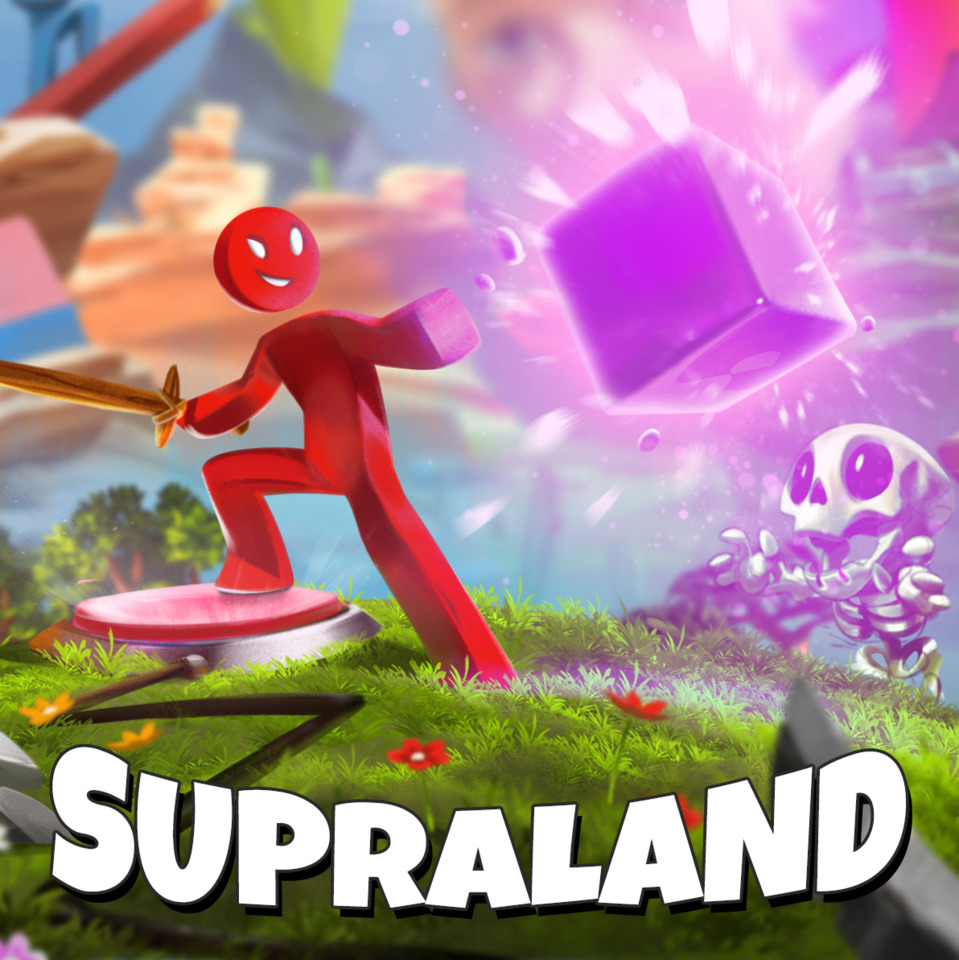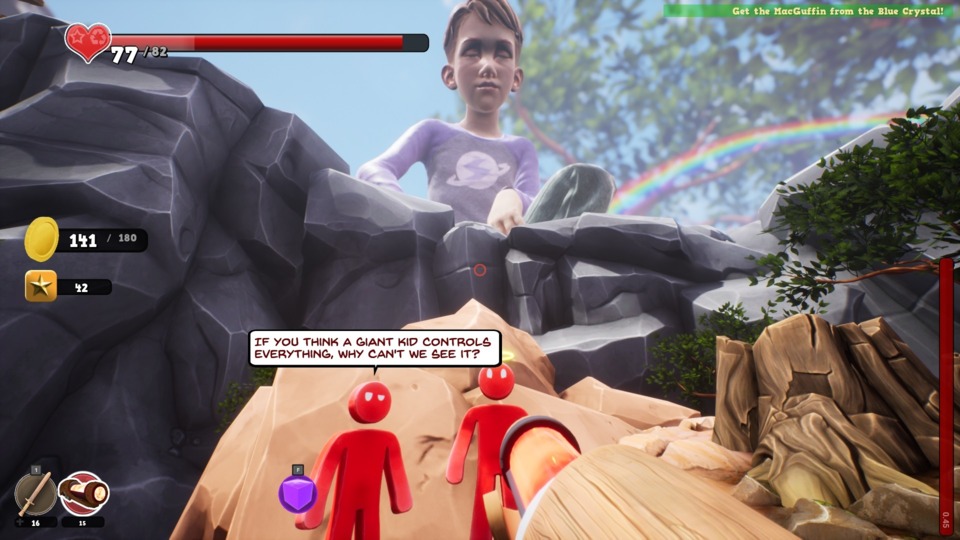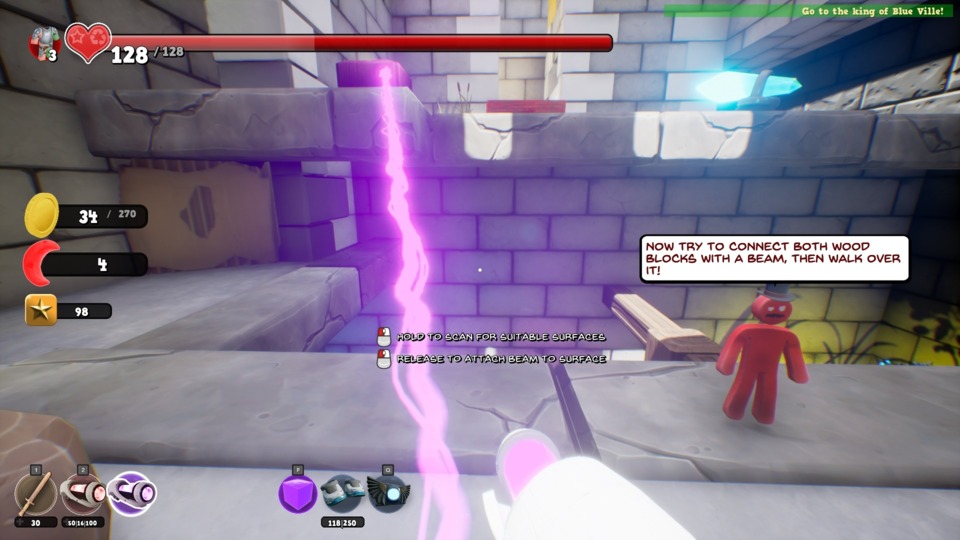Indie Game of the Week 297: Supraland
By Mento 5 Comments

Ahhh, nothing like that new computer smell. And there's nothing like knowing that you can now play the dozens of Indie games you picked up in bundles, on sale, or the weekly freebie from EGS or sometimes sites like GOG whenever sales hit that you put in a special folder called "pfft, maybe someday" because your potato PC practically mashed itself looking at their specs. Suffice it to say, the Indie backlog I draw from for this feature is now well-stocked for 2023 and beyond. One of those previous "never-ran"s is the first-person, open-world, explormer collectathon Supraland. The titular Supraland is a set of little toy figurines in an elaborate outdoor playset created by a particularly imaginative child. You can occasionally see the little guy checking in on what his creations are doing, though "little" might not necessarily apply to the colossal grade-schooler in your midst looming over the horizon like the titans from Xenoblade. The story, such as it is, involves finding out what happened to your town's water supply, discovering a conspiracy involving the rival kingdom, and a whole lot of running jumping around collecting cash and power-ups.
Structurally and gameplay-wise I'd put Supraland somewhere between a The Talos Principle and a Metroid Prime. The former because the game has a heavy emphasis on solving environmental puzzles with the new abilities you keep acquiring while exploring the absolute contours of its areas to find secrets hidden under every rock. Metroid Prime because it's one of the few prior first-person 3D explormers but also because the game's combat resembles it, at least once you find a gun. The combat picks up once firearms are involved—the melee combat with your sword starting weapon is kinda underwhelming, but the gun outclasses it quickly with its range and damage potential—but it still mostly serves as an irritation in most cases, with random skeletal mobs popping up while you're busy focusing your attention on a puzzle or a platforming challenge. (I imagine the developer feedback included many a similar sentiment, because the game's DLC is advertised on Steam as "having way less combat".)

The puzzles, however, are the game's true strength. Many boil down to what you might expect: redirecting lasers, pushing down buttons, or following cables behind walls to find the switches that activate whatever's on the other end. You very quickly unlock a double jump, followed by a triple jump, and upgrades continue to expand the sheer amount of ground you're able to cover. These traversal upgrades are pivotal to the game's flow and its ingenuity when designing puzzles, to the extent that most of them once found immediately then throw you into a gauntlet of puzzles based around your new abilities. When that ability is just using your new gun to activate remote target buttons the game doesn't need to go too far with its tutorializing, but later abilities can be as complex as they are intriguing. One case includes an artifact, turned on and off via a toggle, that magnetizes you: this means being able to ascend and descend any metallic object in the environment (there are several based on common tools and other metal debris sticking out from the dirt that the child presumably found in a garage or shed and repurposed), going up, down, or otherwise around metallic structures, using the magnetism to pull along metallic objects, and so on. Even the sheer versatility of that upgrade couldn't compete with what followed, making a game that is full of surprises once you have a firm grasp on what your new hardware can do and all the spots in prior areas that you can now poke deeper into for more goodies.
On top of the major game-changing upgrades are what feel like several hundred smaller ones concerning your combat strength and other stats. Everything can be increased: Max health, gun firing speed, gun reloading speed, sword reach, damage with the sword, gun, or your ground-pound stomp, loot drops from enemies, the amount of gold you can carry at once, health regen speed, health regen ceiling (that is, the percentage of your health bar that will regenerate on its own), and several others. Many upgrades are purchased from vendors, necessitating that money is a common reward for reaching higher or more elusive places also. The game has so many of these hidden everywhere, to the extent that I recently revisited the mini-dungeon that serves as a tutorial for the game and found two more secret chests down there I had no idea were there (and no means to reach them, at the time) on the first visit. The way your traversal abilities keep expanding your perspective often puts earlier explored locations in a whole new light, your eyes now wandering towards telltale details like colors and textures that meant nothing originally. That is, of course, true for most any explormer but it's all the more potent in the first-person view where perspective is that much more integral. On that note, the triple-jump also assuages the usual irritations involved with first-person platforming as the extra airtime makes it very easy to correct a misjudged leap.

I know there are others on the site that share my affinity for macro-sized miniature worlds: those cases where you're somewhere with familiar objects or a familiar place but happen to be considerably smaller than a regular human. Your typical Honey, I Shrunk the Kids scenario, that is starting to pick up again thanks in part to games like Supraland, Grounded, or Hypercharge: Unboxed. With Supraland, the idea that some kid is behind everything makes itself known in small but amusing ways. The game does have a touch of the meme humor here and there but not to an obnoxious degree, and one mid-game power-up is "awesomeness" which simply tracks how many secrets you've found and has a few areas gated off until you hit certain milestones. Before you see any of those gated-off zones, you might assume an in-game awesomeness tracker was just some random goof. One collectible side-quest concerns coming across dead heroes in out-of-the-way places that are based on various famous figures that you can grave-rob for cosmetic items. The humor is as incidental as the story, but adds an extra dose of personality in a game that might otherwise feel too dry.
I have no idea how much of the game I have left after the ten or so hours I've spent with it already. It feels like the narrative is drawing to its conclusion, but at the same time the in-game progress tracker is hovering just over 60%. Whether that means there's a lot of secret items I've missed, or the story continues past the next objective despite its apparent finality, or if there's some free content updates the developer squeezed in there since; either and all might be possible. It's certainly not a short game by any stretch, and the size and scope of the game world is impressive for what must be a relatively small team. Supraland was developed in Unreal and, graphically, I'd probably say it's not that much to write home about on the whole beyond its macro-micro premise. One issue with the visuals is that it's not always easy to tell what part of the surrounding rockwork is somewhere you can stand or are supposed to be able to access: if you're running across a very narrow outcropping it can sometimes feel like you're sequence-breaking rather than on the intended path to some collectible or other. There's an appeal in that sort of boundary-pushing, "what can I get away with" speedrun-tech meta-exploration too, but given it's not always what the developer had in mind it's hard to credit them for it. Unless it was what they had in mind, in which case it maybe could've been made more apparent. The world design and the cleverness of most of its hidden areas make up for a lot of the middling and ambiguous visuals, however. Now that I've finally come across a power-up that tells me when I'm close to a chest, I'm more than a little jazzed to go searching around previous areas to see what I've missed. There's also one area that serves as a very challenging tower-defense sequence of sorts: I'm itching to get back there with more power-ups to see if I can't defeat it this time. I'll admit that this game is absolute catnip to a collectathon platformer/explormer fanatic like myself, but even if you don't intend to poke into every nook and cranny for all its secrets there's more than enough going on here with its puzzles and platforming to entice any normies too.
Rating: 5 out of 5. (So far.)
| < Back to 296: Wintermoor Tactics Club | The First 100 | The Second 100 | > Forward to 298: Unpacking |
